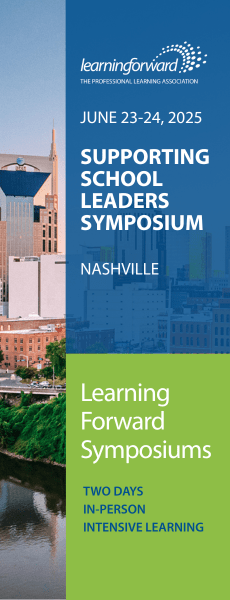Grassroots growth
The evolution of a teacher study group
By Learning Forward
October 2011
Vol. 32 No. 5
Read the remaining content with membership access. Join or log in below to continue.
Sed ut perspiciatis unde omnis iste natus error sit voluptatem accusantium doloremque laudantium, totam rem aperiam, eaque ipsa quae ab illo inventore veritatis et quasi architecto beatae vitae dicta sunt explicabo. Nemo enim ipsam voluptatem quia voluptas sit aspernatur aut odit aut fugit, sed quia consequuntur magni dolores eos qui ratione voluptatem sequi nesciunt. Neque porro quisquam est, qui dolorem ipsum quia dolor sit amet, consectetur, adipisci velit, sed quia non numquam eius modi tempora incidunt ut labore et dolore magnam aliquam quaerat voluptatem.
How to Organize a Teacher Study Group
- Begin with an interest that might be shared by others in a district — not just teachers.
- Put out a call to locate people who share this interest.
- Until you ask, you don’t know who’s out there with common interests. You also don’t know who would be willing to commit.
- Begin with a summer workshop or perhaps time during a district professional day; a district could provide seed money to grow a study group.
- To sustain the study group, seek grants from supporting organizations, such as a district foundation or a partner university. These funds can pay for reading materials.
- Give members ownership; don’t impose on the group.
- Take one step at a time and see where it goes. Allow for organic change. Some people will come and go; new members will join.
Lessons We Have Learned
- The best professional development is not imposed; it is based on teacher interests and offers teachers ownership of their development. The organic quality of self-selected groups promotes choice, commitment, and peer collaboration.
- Don’t limit membership in study groups to educators working in a certain area or level. Study groups can bring unforeseen collaborations.
- Study groups can allow educators to take on leadership roles and to grow as leaders.
References
Barth, R. (2001, February). Teacher leader. Phi Delta Kappan, 82(6), 443-449.
Birchak, B., Connor, C., Crawford, K.M., Kahn, L.H., Kaser, S., Turner, S., & Short, K.G. (1998). Teacher study groups: Building community through dialogue and reflection. Urbana, IL: NCTE.
Cochran-Smith, M. & Lytle, S.S. (1990, March). Research on teaching and teacher research: The issues that divide. Educational Researcher 19(2), 2-11.
Coia, L. & Taylor, M. (2007). From the inside out and the outside in: Co/autoethnography as a means of professional renewal. In Kosnik, C., Beck, C., Freese, A.R., & Samaras, A.P. (Eds.), Making a difference in teacher education through self-study: Studies of personal, professional, and program renewal. Dordrecht, The Netherlands: Kluwer Press.
Coia, L. & Taylor, M. (2003). Writing in the self: Teachers writing autobiographies as a social endeavor. In National Reading Conference Yearbook, 2001. Oak Creek, WI: National Reading Conference.
DuFour, R. & Eaker, R. (1998). Professional learning communities at work: Best practices for enhancing student achievement. Bloomington, IN: Solution Tree.
Freire, P. (2000). Pedagogy of the oppressed. New York: Continuum.
Fullan, M. (1993). Change forces: Probing the depths of educational reform. New York: Routledge.
Harrison, C. & Killion, J. (2007, September). Ten roles for teacher leaders. Educational Leadership, 65(1), 74-77.
Larner, M. (2004). Pathways: Charting a course for professional learning. Portsmouth, NH: Heinemann.
Levine, M. (2008). The price of privilege: How parental pressure and material advantage are creating a generation of disconnected and unhappy people. New York: Harper Paperbacks.
Lieberman, A. (1996). Creating intentional learning communities. Educational Leadership, 50(3),71-74.
Lieberman, A. & Miller, L. (2004). Teacher leadership. San Francisco: Jossey-Bass.
Pearson, C.S. (1989). The hero within: Six archetypes we live by. New York: Harper Collins.
Learning Forward is the only professional association devoted exclusively to those who work in educator professional development. We help our members plan, implement, and measure high-quality professional learning so they can achieve success with their systems, schools, and students.
Recent Issues
LEARNING DESIGNS
February 2025
How we learn influences what we learn. This issue shares essential...
BUILDING BRIDGES
December 2024
Students benefit when educators bridge the continuum of professional...
CURRICULUM-BASED PROFESSIONAL LEARNING
October 2024
High-quality curriculum requires skilled educators to put it into...
LEARNING TO PIVOT
August 2024
Sometimes new information and situations call for major change. This issue...










